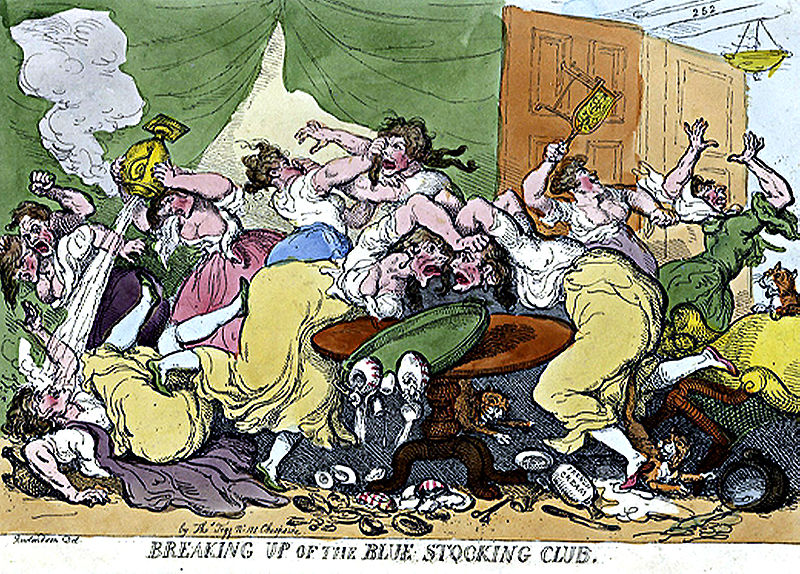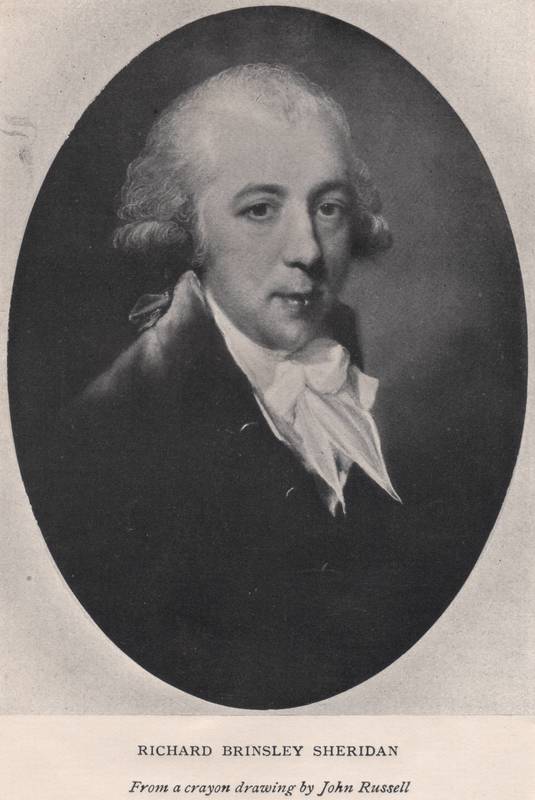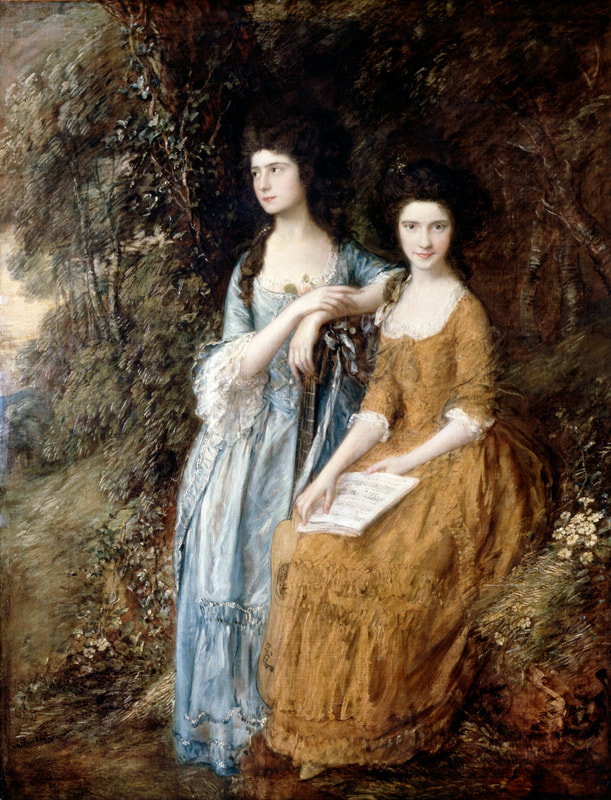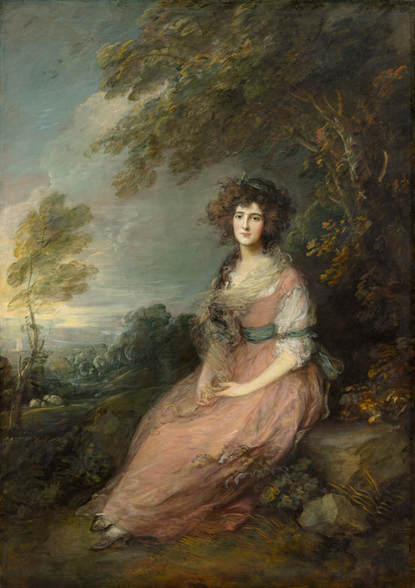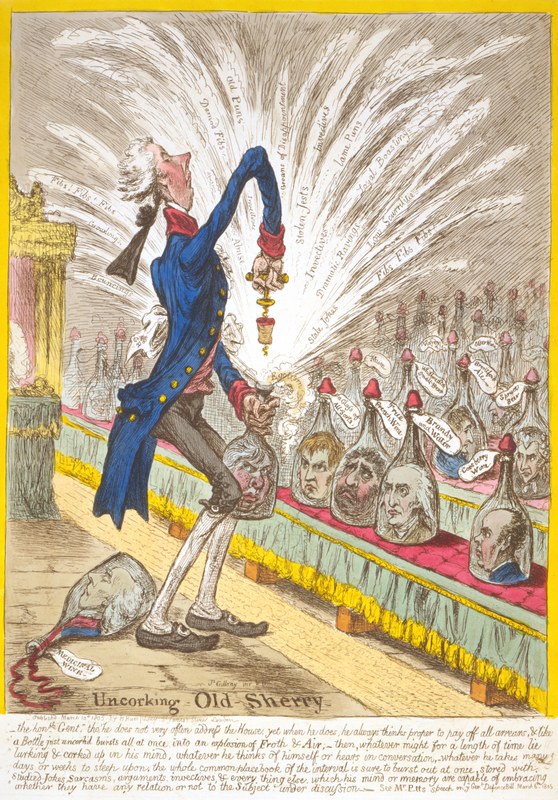|
Richard Brinsley Sheridan's Duels
Alan Payne, April 2019 Richard Brinsley Sheridan was a Georgian man of many parts. Born in Dublin on 30 October 1751, he went to school at Harrow, England, and became a famous playwright, owner of the Theatre Royal, Drury Lane, a Member of Parliament for thirty-two years and was a gentleman of fashion. He was famous in his lifetime for his plays such as The Rivals and The School for Scandal and was buried at Poets' Corner, Westminster Abbey, after his death on 7 July 1816. Right: The Bluestocking Club by Thomas Rowlandson (courtesy Wikipedia) |
As an MP Sheridan supported Charles James Fox's newly-established Whig Party and spoke in favour of the revolutionaries in the American War of Independence and the French Revolution. His barbed and ready wit meant that he incurred many political enemies and, because he always lived above his means, he died in poverty in 1816. So what is the connection with Box?
The Duels, 1772
The answer lies in a love triangle involving a celebrated seventeen year-old beautiful soprano, Elizabeth Ann Linley, his fiancée (later his wife). Sheridan and his family moved to Bath in 1770 and met the Linley family there. Miss Linley was a teenage celebrity, engaged to a 60-year old Squire, Walter Long, who dissolved the contract. In 1772 Captain Thomas Mathews, a married man, forced his attentions on her and threatened to ruin her. She eloped with Sheridan, then 21 years old and only four years older than Elizabeth. They fled to France where Elizabeth took refuge in a convent.
The answer lies in a love triangle involving a celebrated seventeen year-old beautiful soprano, Elizabeth Ann Linley, his fiancée (later his wife). Sheridan and his family moved to Bath in 1770 and met the Linley family there. Miss Linley was a teenage celebrity, engaged to a 60-year old Squire, Walter Long, who dissolved the contract. In 1772 Captain Thomas Mathews, a married man, forced his attentions on her and threatened to ruin her. She eloped with Sheridan, then 21 years old and only four years older than Elizabeth. They fled to France where Elizabeth took refuge in a convent.
|
Sheridan returned to England where Captain Mathews had published articles in the Bath Chronicle calling Sheridan a liar and a treacherous scoundrel. To restore both his honour and that of Elizabeth, Sheridan challenged him to a duel in Hyde Park with swords chosen as the weapon. After a lot of posturing and drawing of swords, the number of passers-by was too large to continue. The combatants then moved to a tavern to fight by candlelight. Mathews' second, Captain Knight, appealed for Mathews' life and they were separated. Sheridan then published an account of Mathew's apology in the Bath Chronicle.[1]
When Mathews considered events he felt that he needed restitution and he challenged Sheridan to another duel, to be fought on 1 July 1772 at Kingsdown, Box.[2] The reports of the protagonists and their seconds makes it clear how brutal duels were in the late 1700s. Mathews' sword was broken, leaving a jagged point tapering up the blade. As they rolled down the sloping ground, he used the broken blade to hack at Sheridan's neck inflicting several wounds. Mathews then used it to stab Sheridan and the sword lodged in the bones of his body. The seconds urged Sheridan to beg for his life but he refused saying No, by God, I won't. Mathews fled the scene and escaped to France assuming that Sheridan was mortally wounded and fearing a charge of murder. Left: Illustration Courtesy Wikipedia |
Sheridan was borne from the field with a portion of his antagonist's weapon sticking through an ear, his breast-bone touched, his whole body covered with wounds and blood, and his face nearly beaten to jelly with the hilt of Mathews' sword. He returned to his home in Bath. Eight days after the duel the Bath Chronicle was able to announce that he was out of danger. Mathews returned to Bath some time later, reckoned to be a military gentleman who played a phenomenal game of whist.
Elizabeth Ann Linley (September 1754 – 28 June 1792)
The object of the duel, Elizabeth Linley, was a member of the famous London Society of Bluestockings (educated women with strong views, who wore fashionable stockings rather than traditional black). She was reckoned to be quite a beauty and a most distinguished singer infinitely superior to all other English singers.[3] Her voice was described as one of the sweetest and most expressive soprano voices of her time.[4] Little wonder with her beauty and other attributes, at the age of eighteen, she was courted by both Sheridan and Mathews.
The object of the duel, Elizabeth Linley, was a member of the famous London Society of Bluestockings (educated women with strong views, who wore fashionable stockings rather than traditional black). She was reckoned to be quite a beauty and a most distinguished singer infinitely superior to all other English singers.[3] Her voice was described as one of the sweetest and most expressive soprano voices of her time.[4] Little wonder with her beauty and other attributes, at the age of eighteen, she was courted by both Sheridan and Mathews.
|
Elizabeth's family were close friends of the painter Thomas Gainsborough, who painted her several times both before and after her elopement and subsequent marriage to Sheridan.
The Sheridans After the duels, Richard and Elizabeth Sheridan moved to London where Sheridan wrote his plays. They had an extensive social circle, based on Elizabeth's theatre and music contacts and Richard's political views, advocating freedom of the press, abolition of slavery, and Catholic Emancipation. When the French Revolution broke out he spoke in favour of it in parliament in speeches of wit and humour, which offended the Tory Party. Elizabeth died in 1792 aged 37. Richard later re-married but he was in serious financial difficulties. In 1809 his Drury Lane theatre burnt down, he lost his seat in Parliament and was imprisoned for debt. He died, aged 65, in 1816. Left: Sheridan Uncorking Old Sherry by Gillray (courtesy Wikipedia) |
Sheridan's exploits in the duel were reported for years after the events. It was one of the last duels fought with the sword, as pistols became the preferred method allowing combatants to deliberately miss without seeming to back down. In the early 1800s three British Prime Ministers had fought a duel - Castlereagh, Canning and Wellington but the practice was in disrepute and the last fatality in England was in 1852 between two Frenchmen. How about a revival - it does make golf on Kingsdown seem rather tame.
References
[1] The Bath Chronicle, 7 May 1772
[2] Linda Carlyle McCollum, http://www.safd.org/Documents/nobygod.html
[3] Francis Burney, also a Bluestocking, wikipedia
[4] Stanley Sadie quoted in Wikipedia
References
[1] The Bath Chronicle, 7 May 1772
[2] Linda Carlyle McCollum, http://www.safd.org/Documents/nobygod.html
[3] Francis Burney, also a Bluestocking, wikipedia
[4] Stanley Sadie quoted in Wikipedia
